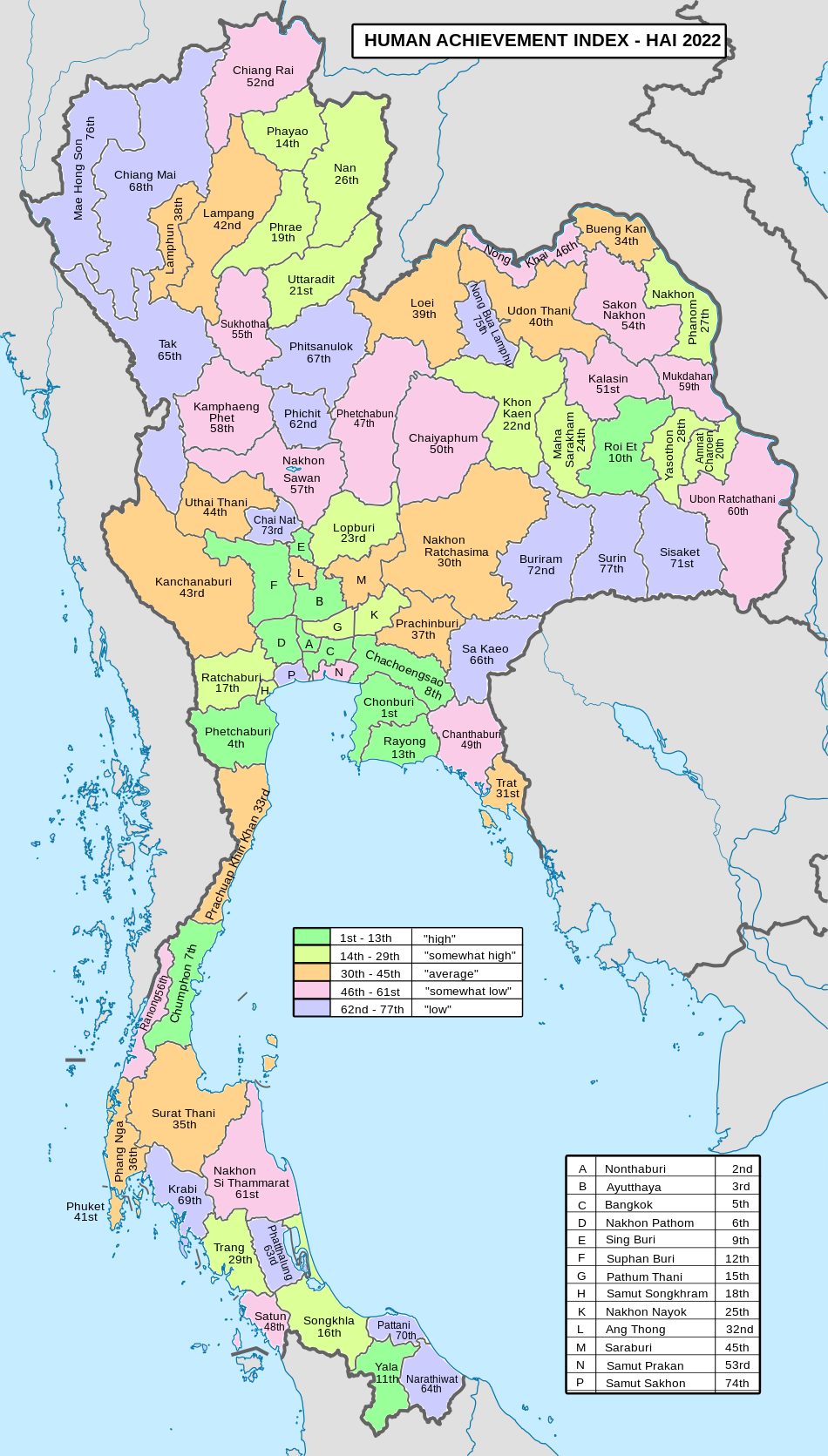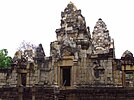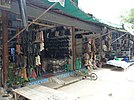Sa Kaeo province
Sa Kaeo
สระแก้ว | |
|---|---|
(Clockwise from top left) Lalu, Prasat Sdok Kok Thom, Locomotive at Aranyaprathet railway station, Boot shops in Rong Kluea border market, Ban Klong Luk Border railway station next to Rong Kluea market | |
| Motto(s): ชายแดนเบื้องบูรพา ป่างามน้ำตกสวย มากด้วยรอยอารยธรรมโบราณ ย่านการค้าไทย-เขมร ("The Eastern border. Beautiful forests and waterfalls. Rich in ancient history. The Thai-Khmer commercial area.") | |
 Map of Thailand highlighting Sa Kaeo province | |
| Country | Thailand |
| Capital | Sa Kaeo |
| Government | |
| • Governor | Parinya Phothisat (since October 2021) |
| Area | |
| • Total | 7,195 km2 (2,778 sq mi) |
| • Rank | Ranked 27th |
| Population (2018)[2] | |
| • Total | 564,092 |
| • Rank | Ranked 45th |
| • Density | 78/km2 (200/sq mi) |
| • Rank | Ranked 64th |
| Human Achievement Index | |
| • HAI (2022) | 0.6207 "low" Ranked 66th |
| GDP | |
| • Total | baht 45 billion (US$1.6 billion) (2019) |
| Time zone | UTC+7 (ICT) |
| Postal code | 27xxx |
| Calling code | 037 |
| ISO 3166 code | TH-27 |
| Website | www |
Sa Kaeo (Thai: สระแก้ว, pronounced [sàʔ kɛ̂ːw]) is one of the 76 provinces (changwat) and lies in eastern Thailand about 200 km from Bangkok. Neighboring provinces are (from south clockwise) Chanthaburi, Chachoengsao, Prachinburi, Nakhon Ratchasima, and Buriram. To the east it borders Banteay Meanchey and Battambang of Cambodia.
History
[edit]Sa Kaeo became a province in 1993, when the six districts Sa Kaeo, Khlong Hat, Wang Nam Yen, Aranyaprathet, Ta Phraya, and Watthana Nakhon of Prachinburi province were elevated to provincial status.[5] It is thus one of the four newest provinces of Thailand, together with Amnat Charoen, Nong Bua Lamphu, and most recently, Bueng Kan.
The province is overwhelmingly Theravada Buddhist (99.4 percent).[6]
In 1979 Sa Kaeo Refugee Camp was established northwest of Sa Kaeo town. It closed in 1989, but the legacy of the border clashes of the 1970s, 1980s, and 1990s is ever present. The largest land mine field in the world was planted along the Thai-Cambodia border according to some experts. Almost 4,000 people have been injured or killed by landmines in Thailand since the border battles—19 persons in 2017 alone. According to a survey conducted in 2001, 27 of Thailand's 76 provinces were plagued with land mines, impacting more than 530 communities and some 500,000 people. Thailand still has approximately 409 km2 of mined area to clear scattered around the country. With an annual clearance rate of about one km2 between 2011 and 2015 the problem will not soon disappear.[7]

The name Sa Kaeo, literally 'crystal pond', refers to two ponds (Sa Kaeo Sa Khwan) containing water thought to be sacred once used for the coronation ceremony. The name of the province originated with this place, now the ponds lie inside a public park next to Mueang Sa Kaeo Municipality Office.[8]
Geography
[edit]The north of the province is covered with the forested mountains of the Sankamphaeng Range and the Dangrek Mountains. The total forest area in 2021 is 1,506 km2 (581 sq mi) or 22 percent of provincial area.[9] To the south are the foothills of the Cardamom Mountains, which are mostly deforested.
National parks
[edit]There are two national parks, along with two other national parks, make up region 1 (Prachinburi) of Thailand's protected areas.
- Pang Sida National Park, 844 km2 (326 sq mi)[10]: 41
- Ta Phraya National Park, 594 km2 (229 sq mi)[10]: 82
Symbols
[edit]The provincial seal shows the sun rising over archaeological ruins, Prasat Khao Noi Si Chompu, a significant Khmer temple.[11] The rising sun symbolizes the location of the province in the east. In the front is a Buddha image in a pond with lotus flowers.[12]
The provincial tree is Phyllanthus emblica. The provincial flower is the Orange Jessamine (Murraya paniculata). The provincial aquatic life is Leptobarbus hoevenii.
The provincial slogan is "Frontier of the east, beautiful forests, splendid waterfalls, ancient civilisations, Thai-Cambodian commerce".
Administrative divisions
[edit]
Provincial government
[edit]Sa Kaeo is divided into nine districts (amphoe). The districts are further divided into 59 subdistricts (tambons) and 619 villages (mubans).
Local government
[edit]As of 26 November 2019 the province had one Provincial Administration Organisation (PAO) (ongkan borihan suan changwat) and 16 municipalities (thesaban): Sa Kaeo, Aranyaprathet, and Wang Nam Yen had town (thesaban mueang) status, with a further 13 subdistrict municipalities (thesaban tambon).[13] (Non-municipal areas are administered by 49 Subdistrict Administrative Organisations (SAO) (ongkan borihan suan tambon).[2]
Human achievement index 2022
[edit]| Health | Education | Employment | Income |
| 44 | 55 | 62 | 62 |
| Housing | Family | Transport | Participation |

|
 |

|
|
| 5 | 49 | 75 | 44 |
| Province Sa Kaeo, with an HAI 2022 value of 0.6207 is "low", occupies place 66 in the ranking. | |||
Since 2003, United Nations Development Programme (UNDP) in Thailand has tracked progress on human development at sub-national level using the Human achievement index (HAI), a composite index covering all the eight key areas of human development. National Economic and Social Development Board (NESDB) has taken over this task since 2017.[3]
| Rank | Classification |
| 1 - 13 | "high" |
| 14 - 29 | "somewhat high" |
| 30 - 45 | "average" |
| 46 - 61 | "somewhat low" |
| 62 - 77 | "low" |
| Map with provinces and HAI 2022 rankings |

|
References
[edit]- ^ Thailand Human Development Report 2014: Advancing Human Development through ASEAN Community (Report). United Nations Development Programme (UNDP). 2014. pp. 134–135. ISBN 978-974-680-368-7. Retrieved 9 June 2022.
- ^ a b "ร่ยงานสถิติจำนวนประชากรและบ้านประจำปี พ.ศ.2561" [Statistics, population and house statistics for the year 2018]. Registration Office Department of the Interior, Ministry of the Interior. stat.bora.dopa.go.th (in Thai). 31 December 2018. Archived from the original on 2 April 2019. Retrieved 20 June 2019. Archived 2 April 2019 at the Wayback Machine
- ^ a b "ข้อมูลสถิติดัชนีความก้าวหน้าของคน ปี 2565 (PDF)" [Human Achievement Index Databook year 2022 (PDF)]. Office of the National Economic and Social Development Council (NESDC) (in Thai). Retrieved 12 March 2024, page 76
{{cite web}}: CS1 maint: postscript (link) - ^ "Gross Regional and Provincial Product, 2019 Edition". <>. Office of the National Economic and Social Development Council (NESDC). July 2019. ISSN 1686-0799. Archived from the original on 25 November 2023. Retrieved 22 January 2020.
- ^ "Sa Kaeo". Tourism Authority of Thailand (TAT). Retrieved 1 May 2018.
- ^ "Population by religion, region and area, 2015" (PDF). National Statistical Office. Archived from the original (PDF) on 2017-12-10. Retrieved 2017-10-12.
- ^ Taylor, Caitlin (7 January 2018). "Long fight against a hidden killer". Bangkok Post (Spectrum). Retrieved 7 January 2018.
- ^ "Sa Kaeo Sa Khwan". Tourism Authority of Thailand.
- ^ โครงการจัดทำข้อมูลสภาพพื้นที่ป่าไม้ ปี พ.ศ. 2564 [Forest area data project 2021] (PDF) (Report) (in Thai). Royal Forest Department. 2021. p. 11. Archived from the original (PDF) on 9 June 2022. Retrieved 9 June 2022.
- ^ a b "ข้อมูลพื้นที่อุทยานแห่งชาติ ที่ประกาศในราชกิจจานุบกษา 133 แห่ง" [National Park Area Information published in the 133 Government Gazettes]. Department of National Parks, Wildlife and Plant Conservation (in Thai). December 2020. Archived from the original on 3 November 2022. Retrieved 1 November 2022.
- ^ "Khao Noi Si Chompu Castle". Tourism Authority of Thailand. Retrieved 13 May 2021.
- ^ "Sa Kaeo Provincial Escutcheon". Thailex. Retrieved 13 May 2021.
- ^ "Number of local government organizations by province". Department of Local Administration (DLA). 26 November 2019. Retrieved 10 December 2019.
63 Sa Kaeo: 1 PAO, 3 town municipalities, 13 subdistrict municipalities, 49 SAO.
External links
[edit] Sa Kaeo travel guide from Wikivoyage
Sa Kaeo travel guide from Wikivoyage- Website of the province Archived 2011-07-20 at the Wayback Machine
- Sa Kaeo provincial map, coat of arms and postal stamp








